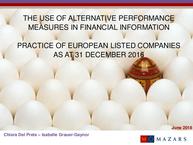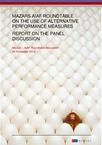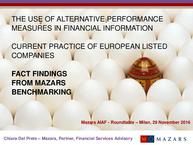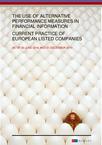The use of APM in financial information: current practice of European listed entities
APMs are financial measures of performance used by management and derived from the financial statements prepared according to the relevant financial reporting rules, subtracting, adding or aggregating amounts from the figures presented therein, but they are not defined in the applicable reporting framework (e.g. EBIT, EBITDA, Free Cash Flow, etc.). On 3 July 2016 the new ESMA Guidelines entered into force, setting criteria for the presentation of APMs for issuers to follow when using such indicators in their regulated financial information (including financial reports and press releases announcing their results) and in Prospectuses. National Competent Authorities also have had as enforcement priority for financial information related to 2016 and 2017 to assess its compliance to ESMA’s Guidelines on APMs, with the objective to promote comparability, reliability and comprehensibility of APMs.
Mazars’ Study
In 2016, Mazars analysed the financial information (financial statements, press releases on results and presentations to the analysts) for the first half 2016 and for the year-end 2015 issued by all the entities belonging to the EUROSTOXX 50 index. Mazars’ study confirms that APMs play a key role in financial communication and that there is a certain level of consistency per segment in the indicators used. However, the study shows that there are still significant differences in the content of the indicators used, despite them using the same label. The indicators can also be identified under different labels.
The study highlights a trend to comment on adjusted earnings indicators, i.e. net of items qualified as non-recurring or extraordinary, but which, because of their nature, occur in different periods. Finally, although APM definitions are generally provided and worded clearly, APMs are often presented with more prominence than their IFRS most reconcilable indicator, especially in the press releases and in the presentations to analysts
In 2018, Mazars updated its initial study for 2016 financial information whilst enlarging the sample to include UK companies as well as small and mid-cap companies. This study confirms the trends identified in the previous years both for the original sample and the enlarged samples.
Read the full benchmarking reports and discover the key findings via the downloads below.
The 29 November 2016 roundtable
The results of Mazars’ study were the subject of discussion in a prestigious roundtable jointly organised by Mazars and AIAF (Association of Italian Financial Analysts) that took place in Milan on 29 November 2016. Panellists in the roundtable were international, European and national representatives of analyst organisations (EFFAS, AIAF), regulators (ESMA, Consob), standard-setters (IASB, EFRAG, OIC) and companies (BusinessEurope).
The discussion confirmed that, considering their relevance and widespread use in financial communication, APMs will continue to play a role and, accordingly, standard-setters and supervisory authorities have in front of them a journey to undertake. In particular, the IASB is currently starting a research project aimed at assessing whether and to what extent there is a need to modify the structure of IFRS primary statements in order to include some largely used APMs, including EBIT. ESMA, on the other side, will monitor compliance with the Guidelines.





